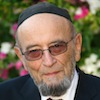Bonjour,
En le Talmud, on peut trouver le récit suivant (désolé, c'est en anglais, je ne l'ai pas trouvé en français):
Hadrian once asked R. Yehoshua ben Chananya: 'From what will G-d resurrect man in the future world?' R. Yehoshua replied, 'From the luz in the spine.' " Once God has softened this bone with the Dew of Resurrection, it will become as yeast is to the dough, and from it the body will be built. The same body that decomposed will be reconstructed. This is implied by the verse, "Your dead people shall live" (and not "shall be created"). As to identifying the luz, some say that it is the coccyx, a small bone at the base of the spine; others say that it is the bone at the back of the skull upon which the knot of the tefillin shel rosh is placed.
One day, a Jew passed the imperial train and saluted the Emperor Hadrian, who waxed furious: "You, a Jew, dare to greet the Emperor! You shall pay for this with your life!" Later that day, another Jew passed the Emperor and did not greet him. " A Jew dares to pass a Roman Emperor without saluting?" Hadrian exclaimed. "You shall be killed!" To this puzzled courtiers, Hadrian explained, "I hate Jews, so I use any excuse to destroy them."
'And the almond shall blossom' refers to the luz (nut) of the spinal column. Hadrian, (may his bones be crushed), asked R. Joshua b. Hananiah, saying: 'From which part of the body will the Holy One, blessed be He, in the Time to Come, cause man to sprout forth? ' He answered: ' From the nut of the spinal column.' Said he: 'How can you convince me?' He thereupon brought one before him; he put it in water, but it was not dissolved; he let it pass through millstones, but it was not ground; he put it in fire, but it was not burnt; he put it on an anvil and began beating it with a hammer, but the anvil was flattened out, and the hammer was split, but all this had no effect."
http://www.antinopolis.org/hadrianmidrash.html
Ma question est : cette histoire est t'elle considéré comme vraie, ou est-ce que cette histoire fut imaginée afin de donner un enseignement?
Je demande ceci, car Jewish Encyclopedia, semble regarder ceci en tant que légende:
Aramaic name for the os coccyx, the "nut" of the spinal column. The belief was that, being indestructible, it will form the nucleus for the resurrection of the body. The Talmud narrates that the emperor Hadrian, when told by R. Joshua that the revival of the body at the resurrection will take its start with the "almond," or the "nut," of the spinal column, had investigations made and found that water could not soften, nor fire burn, nor the pestle and mortar crush it (Lev. R. xviii.; Eccl. R. xii.). The legend of the "resurrection bone," connected with Ps. xxxiv. 21 (A. V. 20: "unum ex illis [ossibus] non confringetur") and identified with the cauda equina (see Eisenmenger, "Entdecktes Judenthum," ii. 931-933), was accepted as an axiomatic truth by the Christian and Mohammedan theologians and anatomists, and in the Middle Ages the bone received the name "Juden Knöchlein" (Jew-bone; see Hyrtl, "Das Arabische und Hebräische in der Anatomie," 1879, pp. 165-168; comp. p. 24). Averroes accepted the legend as true (see his "Religion und Philosophie," transl. by Müller, 1875, p. 117; see also Steinschneider, "Polemische Literatur," 1877, pp. 315, 421; idem, "Hebr. Bibl." xxi. 98; idem, "Hebr. Uebers." p. 319; Löw, "Aramäische Pflanzennamen," 1881, p. 320). Possibly the legend owes its origin to the Egyptian rite of burying "the spinal column of Osiris" in the holy city of Busiris, at the close of the days of mourning for Osiris, after which his resurrection was celebrated (Brugsch, "Religion und Mythologie," 1888, pp. 618, 634).
http://www.jewishencyclopedia.com/view.jsp?artid=635&letter=L
Merci d'avance, pour votre réponse.
Cordialement,
David

